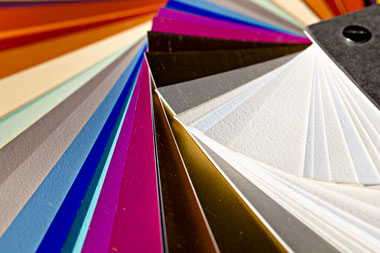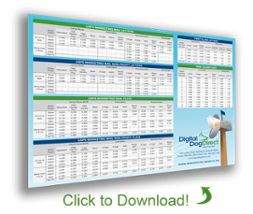 Specifying the type of paper on which your marketing piece will be printed is a critical component of the design process and more than just a finishing touch. The right paper can help showcase your desired positioning like class, value, and even environmentalism through the proper selection of color, weight, finish, and texture.
Specifying the type of paper on which your marketing piece will be printed is a critical component of the design process and more than just a finishing touch. The right paper can help showcase your desired positioning like class, value, and even environmentalism through the proper selection of color, weight, finish, and texture.
Depending on such variables as ink coverage, number of pages, and the method of distributing the printed product, you will want to ensure that you have selected the right paper choice for the job.
A good way to achieve that is to reference paper swatch books well before going to press to select the color of your paper as well as the type of texture, finish, and weight.
Weight Choices include:
- For lightweight options, choose Text – From 24lb. Writing to 80lb. Text
- For heavyweight options, choose Cover – From 65lb. Cover to 16pt. Card Stock
Popular Finish Choices Include:
- Gloss
- Matte/Silk
- Uncoated
Popular Texture Choices Include:
- Felt
- Smooth
- Vellum
- Linen
- Laid or Handmade Feel
Your paper choice helps communicate what kind of brand you are to your audience. These examples demonstrate how paper choice reflects an industry image:
- An environmental organization may use an 80lb. uncoated, earth tone text with 80% recycled post-consumer fiber. A lightweight paper without any coating and neutral tones exhibits a natural look.
- An upscale hotel can use a heavyweight 12pt. gloss coat, bright white cover to demonstrate cleanliness and refinement.
- A financial services marketer may choose 100lb. uncoated cover. This will express a sturdy, established, and time-tested message.
A few other considerations to keep in mind when selecting paper include:
- Opacity — If you have heavy ink coverage, you will need to specify a heavyweight text or cover to prevent show through.
- Postal Regulations— Mock up your direct mail package with your selected stock to determine your postal rate and mailing eligibility. You might want to lower the specified paper weight to reduce postage. lf you are mailing postcards, lightweight card stock works fine for small cards, but will be too flimsy for oversize cards Be sure to cut a sample out to ensure that the paper holds up to the card size.
- Readability & Usability — If your project is text heavy, you may want to avoid a reflective glossy finish, which is harder to read than a soft, matte finish. If this is a form or worksheet, use uncoated paper so it is easy to write on without smudging.
- Number of Pages — A saddle-stitched booklet will function better if the internal pages are a lighter text weight paper whereas a four-page brochure can handle a heavier cover weight stock. Also consider combining stock options to achieve the desired result.
Selecting paper is a fun component of the creative process. Just ask your Customer Service Team member at Digital Dog Direct for some samples to get started today.



Comments